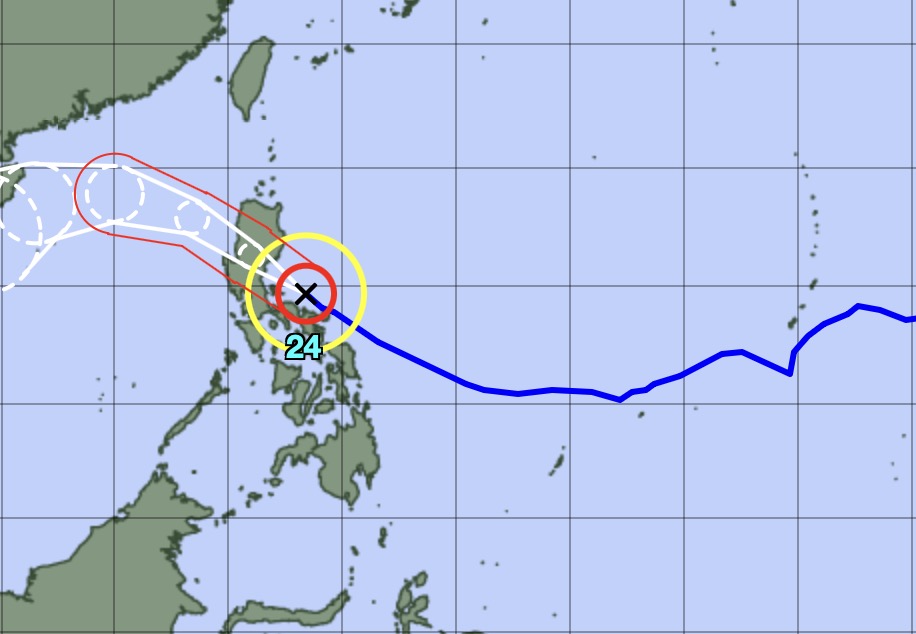The latest storm news from the Philippine weather agency PAGASA said that on the morning of November 17, super typhoon Man-yi continued to be active in the Philippines and was moving over the sea east of the Bicol region.
The eye of Super Typhoon Man-yi is 85 km northeast of Daet, Camarines Norte. This super typhoon near the East Sea has maximum sustained winds near the eye of 185 km/h, with gusts of up to 255 km/h.
Super Typhoon Man-yi is forecast to move west-northwest over the northern waters of Camarines Province (not excluding the possibility of making landfall or approaching the Calaguas Islands) on the morning of November 17.
Philippine typhoon forecasters said that Super Typhoon Man-yi will move out to the coastal waters of Pangasinan or La Union on the evening of November 17 or early morning of November 18. As the latest storm in the South China Sea, Super Typhoon Man-yi will continue to move west-northwest on November 18.
According to the storm news from Yale University, USA, when super typhoon Man-yi made landfall on Catanduanes Island in the Philippines at 9:40 pm on November 16, local time, the US Navy's Joint Typhoon Warning Center (JTWC) determined that Man-yi was at the intensity of a super typhoon of level 5 on the Saffir-Simpson scale.
The Philippines has been hit by unprecedented devastation from November storms, with Man-yi becoming the fourth typhoon to hit the country in less than 10 days.
Four storms hit the Philippines: Typhoon Yinxing (level 4) on November 7, Typhoon Toraji (level 1) on November 11, super typhoon Usagi (level 4) on November 14, and super typhoon Man-yi (level 5) on November 16.
According to the AP news agency, right before super typhoon Man-yi, three previous storms hit the Philippines in November, killing at least 160 people and displacing more than 9 million people.

In addition, nine other tropical storms or super typhoons caused severe damage in the Philippines in 2024: Typhoon Ewiniar (landed as a tropical storm on May 24-27) killed 6 people and caused $20 million in damage. Typhoon Gaemi (did not make landfall, occurred on July 24-25) caused $177 million in damage; Typhoon Shanshan did not make landfall, occurred on August 28; Typhoon Yagi made landfall as a tropical storm from September 1-9; Typhoon Bebinca occurred from August 13-16, did not make landfall. Tropical Storm Soulik made landfall as a tropical storm, affecting from September 15-19; Typhoon Krathon occurred from September 29-30, did not make landfall; Typhoon Trami made landfall as a tropical storm on October 24. Super typhoon Kong-rey did not make landfall, appearing on October 30.
Super Typhoon Man-yi is the fifth Category 5 super typhoon globally in the 2024 hurricane season. Other Category 5 storms include two Atlantic hurricanes, Super Typhoon Beryl and Super Typhoon Milton, a western Pacific storm, Super Typhoon Yagi, and an eastern Pacific storm, Super Typhoon Kristy. The strongest super typhoon on the planet in 2024 is Super Typhoon Milton, which topped out at 180 mph (290 km/h).
The global average for the period 1990-2023 was 5.3 Category 4 super typhoons. Therefore, the 2024 typhoon season, with the presence of Super Typhoon Man-yi, has become a season with a near-average number of Category 5 super typhoons. The record is 12 Category 5 super typhoons in a year, set in 1997. The 2023 typhoon season has 9 Category 5 super typhoons.
According to a global database released by Colorado State University, the 2024 hurricane season has recorded 57 tropical storms as of November 16.











